Cybersecurity: Analysis of Threats, Solutions, and Recommendations
VerifiedAdded on 2021/06/14
|10
|2985
|80
Report
AI Summary
This report provides an overview of cybersecurity, focusing on the protection of networks and systems from digital attacks. It highlights the increasing threats faced by organizations, particularly in banking and financial sectors, emphasizing the importance of proactive security measures. The report discusses potential consequences of security breaches, such as data loss and financial extortion, and offers practical solutions like updating software, creating strong passwords, using antivirus and anti-malware applications, and securing public Wi-Fi connections. The report also suggests specific actions to address cybersecurity issues, including keeping programs updated, using encryption on public networks, creating strong passwords, and regularly changing them. Furthermore, it underscores the importance of backing up data and protecting Wi-Fi networks. The report emphasizes the necessity of a multi-layered approach to cybersecurity, including technical and behavioral best practices, to ensure data integrity, confidentiality, and availability.
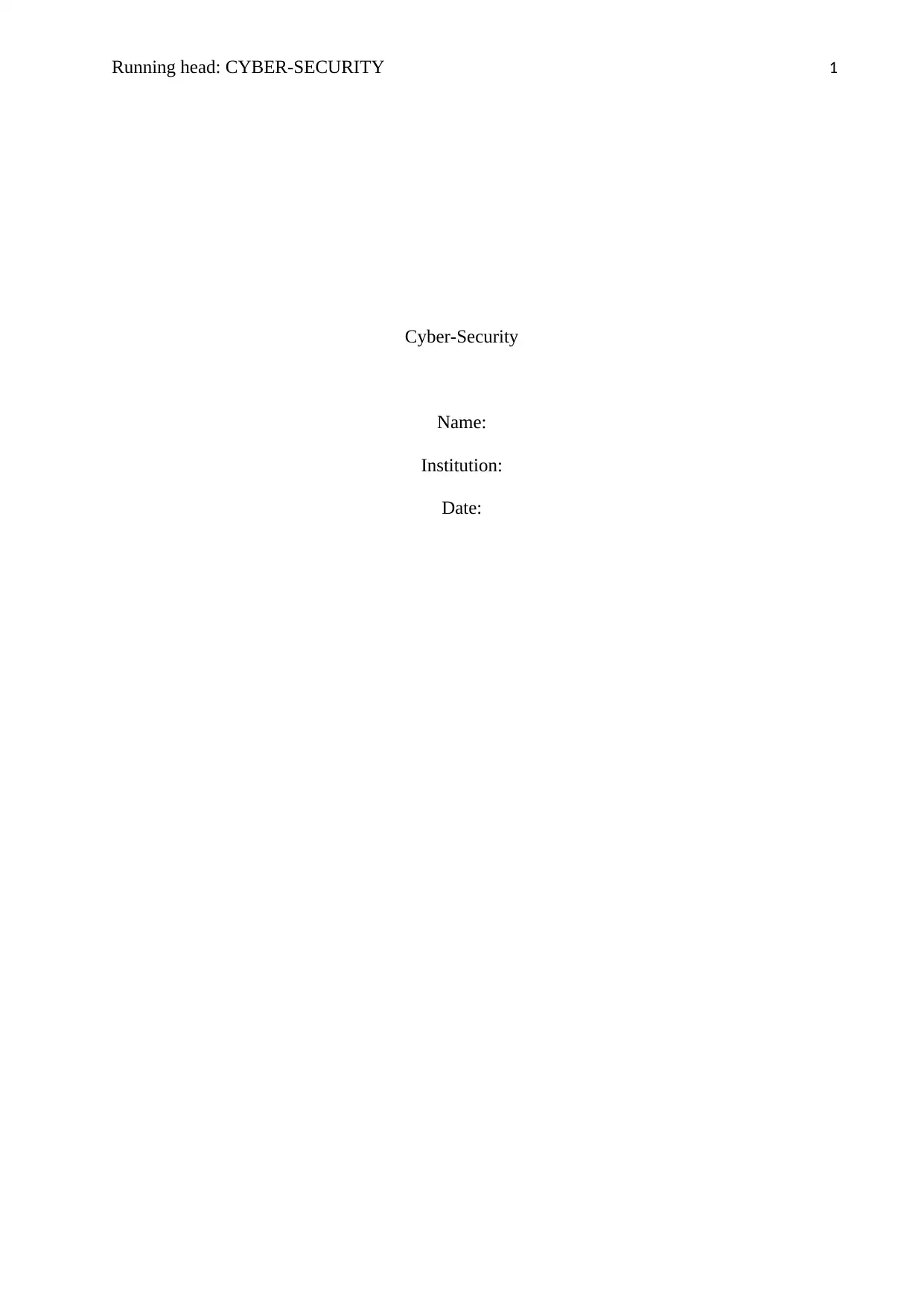
Running head: CYBER-SECURITY 1
Cyber-Security
Name:
Institution:
Date:
Cyber-Security
Name:
Institution:
Date:
Paraphrase This Document
Need a fresh take? Get an instant paraphrase of this document with our AI Paraphraser

CYBER-SECURITY 2
Introduction
Cybersecurity is the practice of system protection, protecting and securing networks and
other programs from digital attack. The attacks are aimed at changing, destroying and
accessing information which is sensitive to an organization. Most of the cyber-attacks are
aimed at extorting money and interrupting standard business processes. But it is within an
organization to build a cyber-security strategy practice of ensuring that there is information
integrity, confidentiality, and availability. It also represents the recovery from hard drive
failures out of attacks from adversaries and power failures (Bonaci, Herron, Yusuf, Yan,
Kohno, & Chizeck, 2015).
The cyber-security issue is the loss of essential data through banking hacks and mobile
payment. Mobile payments have become a disruption, and banks are going the same way.
With millions of attacks targeting banks and financial institutions where cybersecurity
experts are scrambling to avoid intuitional attacks.
Although in many companies for they consider that the IoT is one of the primary agents of
positive change, some experts have begun to express the mistaken idea that this trend should
instead be called "the Internet of threats (Benson, McAlaney, & Frumkin, 2018).
Why the chosen cyber security is being included in the issue
It turns out that part of the intelligent devices that have full use in the banking and processing
industry were installed without security protocols. Of course, those who introduced them did
so on the assumption that they would be used in a closed and safe environment. However,
recent violations of cybersecurity have shown that even the most straightforward banking
system can be cheated for malicious purposes (Sidorov, Lam & Salleh,2017).
Introduction
Cybersecurity is the practice of system protection, protecting and securing networks and
other programs from digital attack. The attacks are aimed at changing, destroying and
accessing information which is sensitive to an organization. Most of the cyber-attacks are
aimed at extorting money and interrupting standard business processes. But it is within an
organization to build a cyber-security strategy practice of ensuring that there is information
integrity, confidentiality, and availability. It also represents the recovery from hard drive
failures out of attacks from adversaries and power failures (Bonaci, Herron, Yusuf, Yan,
Kohno, & Chizeck, 2015).
The cyber-security issue is the loss of essential data through banking hacks and mobile
payment. Mobile payments have become a disruption, and banks are going the same way.
With millions of attacks targeting banks and financial institutions where cybersecurity
experts are scrambling to avoid intuitional attacks.
Although in many companies for they consider that the IoT is one of the primary agents of
positive change, some experts have begun to express the mistaken idea that this trend should
instead be called "the Internet of threats (Benson, McAlaney, & Frumkin, 2018).
Why the chosen cyber security is being included in the issue
It turns out that part of the intelligent devices that have full use in the banking and processing
industry were installed without security protocols. Of course, those who introduced them did
so on the assumption that they would be used in a closed and safe environment. However,
recent violations of cybersecurity have shown that even the most straightforward banking
system can be cheated for malicious purposes (Sidorov, Lam & Salleh,2017).
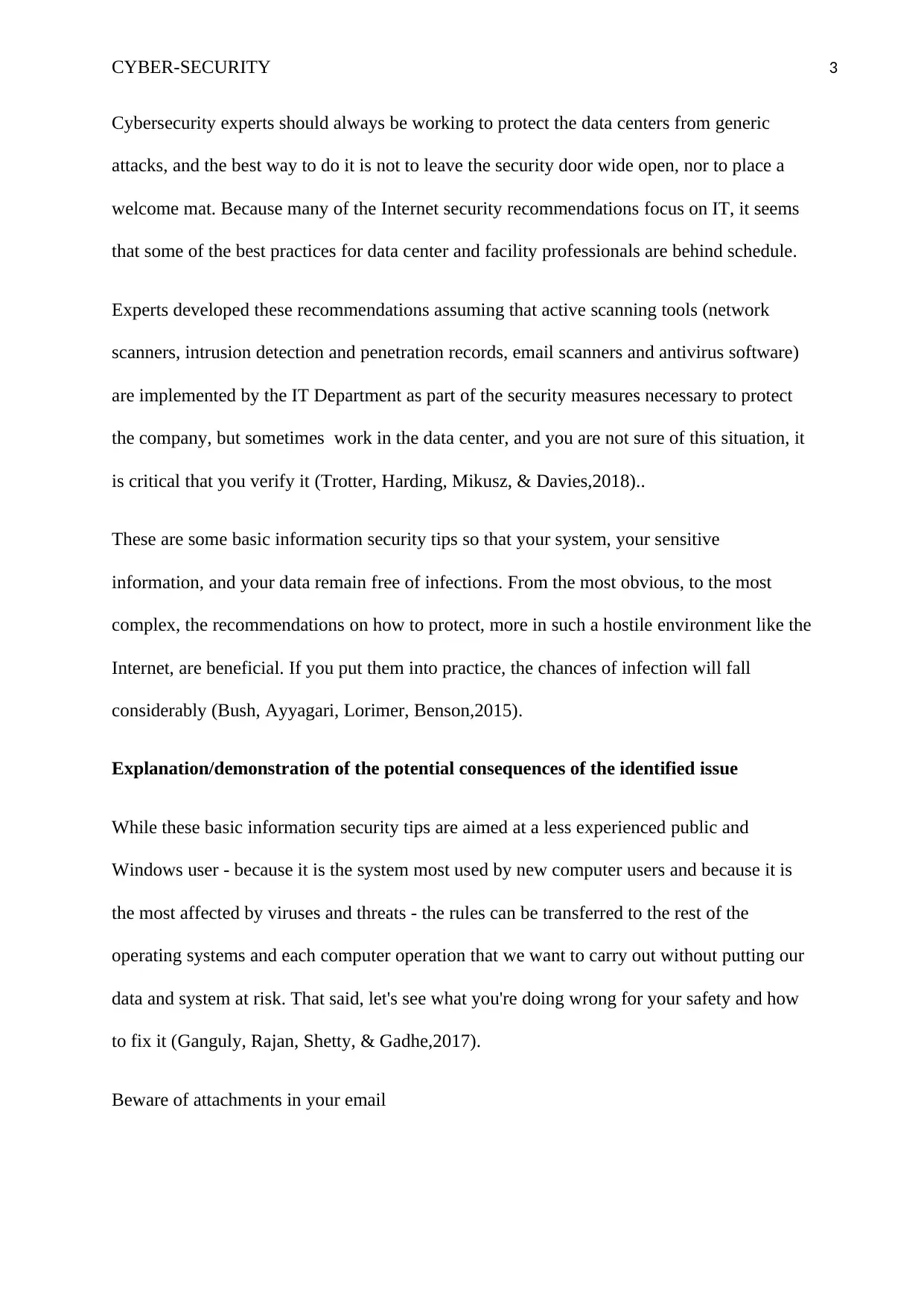
CYBER-SECURITY 3
Cybersecurity experts should always be working to protect the data centers from generic
attacks, and the best way to do it is not to leave the security door wide open, nor to place a
welcome mat. Because many of the Internet security recommendations focus on IT, it seems
that some of the best practices for data center and facility professionals are behind schedule.
Experts developed these recommendations assuming that active scanning tools (network
scanners, intrusion detection and penetration records, email scanners and antivirus software)
are implemented by the IT Department as part of the security measures necessary to protect
the company, but sometimes work in the data center, and you are not sure of this situation, it
is critical that you verify it (Trotter, Harding, Mikusz, & Davies,2018)..
These are some basic information security tips so that your system, your sensitive
information, and your data remain free of infections. From the most obvious, to the most
complex, the recommendations on how to protect, more in such a hostile environment like the
Internet, are beneficial. If you put them into practice, the chances of infection will fall
considerably (Bush, Ayyagari, Lorimer, Benson,2015).
Explanation/demonstration of the potential consequences of the identified issue
While these basic information security tips are aimed at a less experienced public and
Windows user - because it is the system most used by new computer users and because it is
the most affected by viruses and threats - the rules can be transferred to the rest of the
operating systems and each computer operation that we want to carry out without putting our
data and system at risk. That said, let's see what you're doing wrong for your safety and how
to fix it (Ganguly, Rajan, Shetty, & Gadhe,2017).
Beware of attachments in your email
Cybersecurity experts should always be working to protect the data centers from generic
attacks, and the best way to do it is not to leave the security door wide open, nor to place a
welcome mat. Because many of the Internet security recommendations focus on IT, it seems
that some of the best practices for data center and facility professionals are behind schedule.
Experts developed these recommendations assuming that active scanning tools (network
scanners, intrusion detection and penetration records, email scanners and antivirus software)
are implemented by the IT Department as part of the security measures necessary to protect
the company, but sometimes work in the data center, and you are not sure of this situation, it
is critical that you verify it (Trotter, Harding, Mikusz, & Davies,2018)..
These are some basic information security tips so that your system, your sensitive
information, and your data remain free of infections. From the most obvious, to the most
complex, the recommendations on how to protect, more in such a hostile environment like the
Internet, are beneficial. If you put them into practice, the chances of infection will fall
considerably (Bush, Ayyagari, Lorimer, Benson,2015).
Explanation/demonstration of the potential consequences of the identified issue
While these basic information security tips are aimed at a less experienced public and
Windows user - because it is the system most used by new computer users and because it is
the most affected by viruses and threats - the rules can be transferred to the rest of the
operating systems and each computer operation that we want to carry out without putting our
data and system at risk. That said, let's see what you're doing wrong for your safety and how
to fix it (Ganguly, Rajan, Shetty, & Gadhe,2017).
Beware of attachments in your email
⊘ This is a preview!⊘
Do you want full access?
Subscribe today to unlock all pages.

Trusted by 1+ million students worldwide
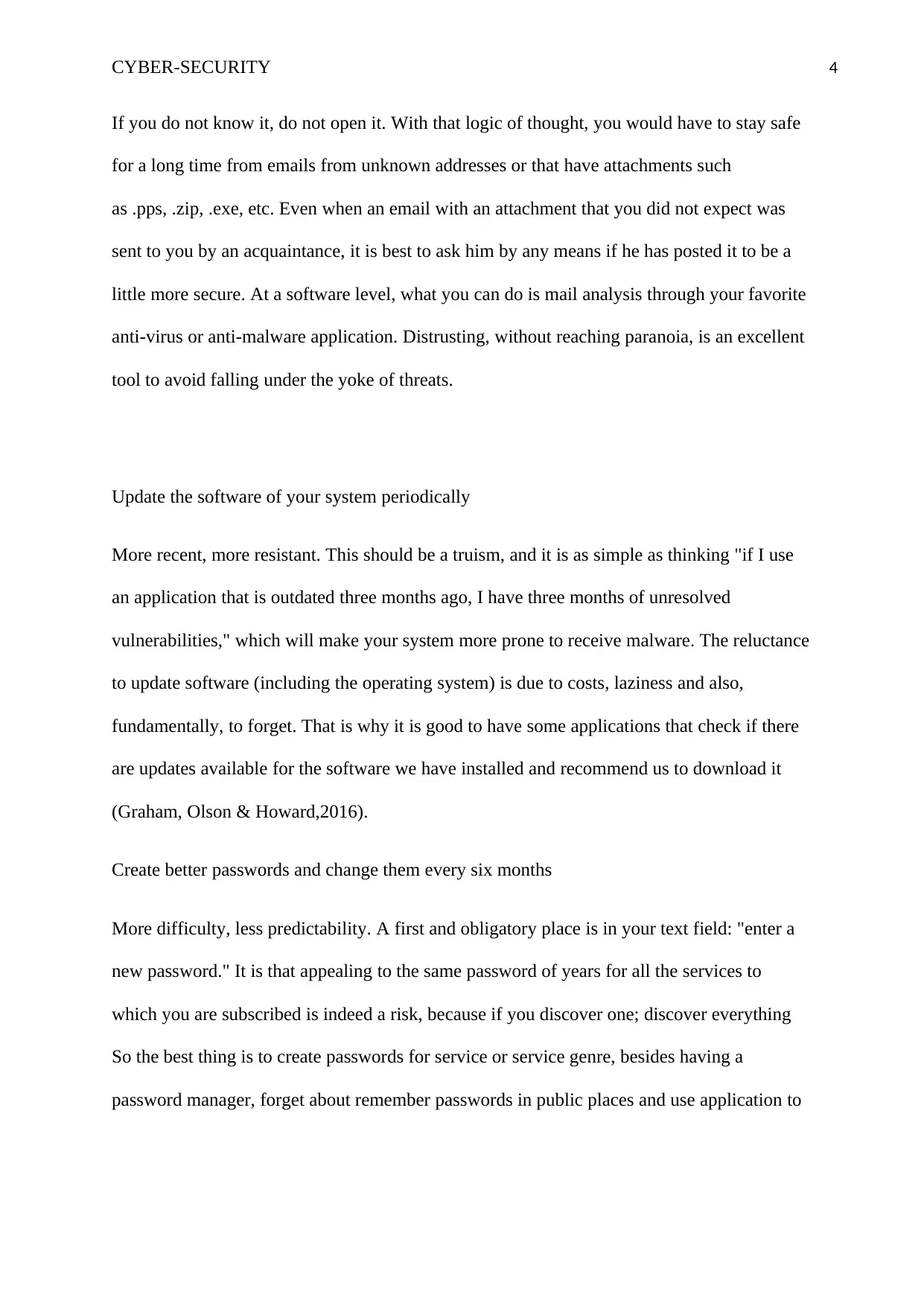
CYBER-SECURITY 4
If you do not know it, do not open it. With that logic of thought, you would have to stay safe
for a long time from emails from unknown addresses or that have attachments such
as .pps, .zip, .exe, etc. Even when an email with an attachment that you did not expect was
sent to you by an acquaintance, it is best to ask him by any means if he has posted it to be a
little more secure. At a software level, what you can do is mail analysis through your favorite
anti-virus or anti-malware application. Distrusting, without reaching paranoia, is an excellent
tool to avoid falling under the yoke of threats.
Update the software of your system periodically
More recent, more resistant. This should be a truism, and it is as simple as thinking "if I use
an application that is outdated three months ago, I have three months of unresolved
vulnerabilities," which will make your system more prone to receive malware. The reluctance
to update software (including the operating system) is due to costs, laziness and also,
fundamentally, to forget. That is why it is good to have some applications that check if there
are updates available for the software we have installed and recommend us to download it
(Graham, Olson & Howard,2016).
Create better passwords and change them every six months
More difficulty, less predictability. A first and obligatory place is in your text field: "enter a
new password." It is that appealing to the same password of years for all the services to
which you are subscribed is indeed a risk, because if you discover one; discover everything
So the best thing is to create passwords for service or service genre, besides having a
password manager, forget about remember passwords in public places and use application to
If you do not know it, do not open it. With that logic of thought, you would have to stay safe
for a long time from emails from unknown addresses or that have attachments such
as .pps, .zip, .exe, etc. Even when an email with an attachment that you did not expect was
sent to you by an acquaintance, it is best to ask him by any means if he has posted it to be a
little more secure. At a software level, what you can do is mail analysis through your favorite
anti-virus or anti-malware application. Distrusting, without reaching paranoia, is an excellent
tool to avoid falling under the yoke of threats.
Update the software of your system periodically
More recent, more resistant. This should be a truism, and it is as simple as thinking "if I use
an application that is outdated three months ago, I have three months of unresolved
vulnerabilities," which will make your system more prone to receive malware. The reluctance
to update software (including the operating system) is due to costs, laziness and also,
fundamentally, to forget. That is why it is good to have some applications that check if there
are updates available for the software we have installed and recommend us to download it
(Graham, Olson & Howard,2016).
Create better passwords and change them every six months
More difficulty, less predictability. A first and obligatory place is in your text field: "enter a
new password." It is that appealing to the same password of years for all the services to
which you are subscribed is indeed a risk, because if you discover one; discover everything
So the best thing is to create passwords for service or service genre, besides having a
password manager, forget about remember passwords in public places and use application to
Paraphrase This Document
Need a fresh take? Get an instant paraphrase of this document with our AI Paraphraser
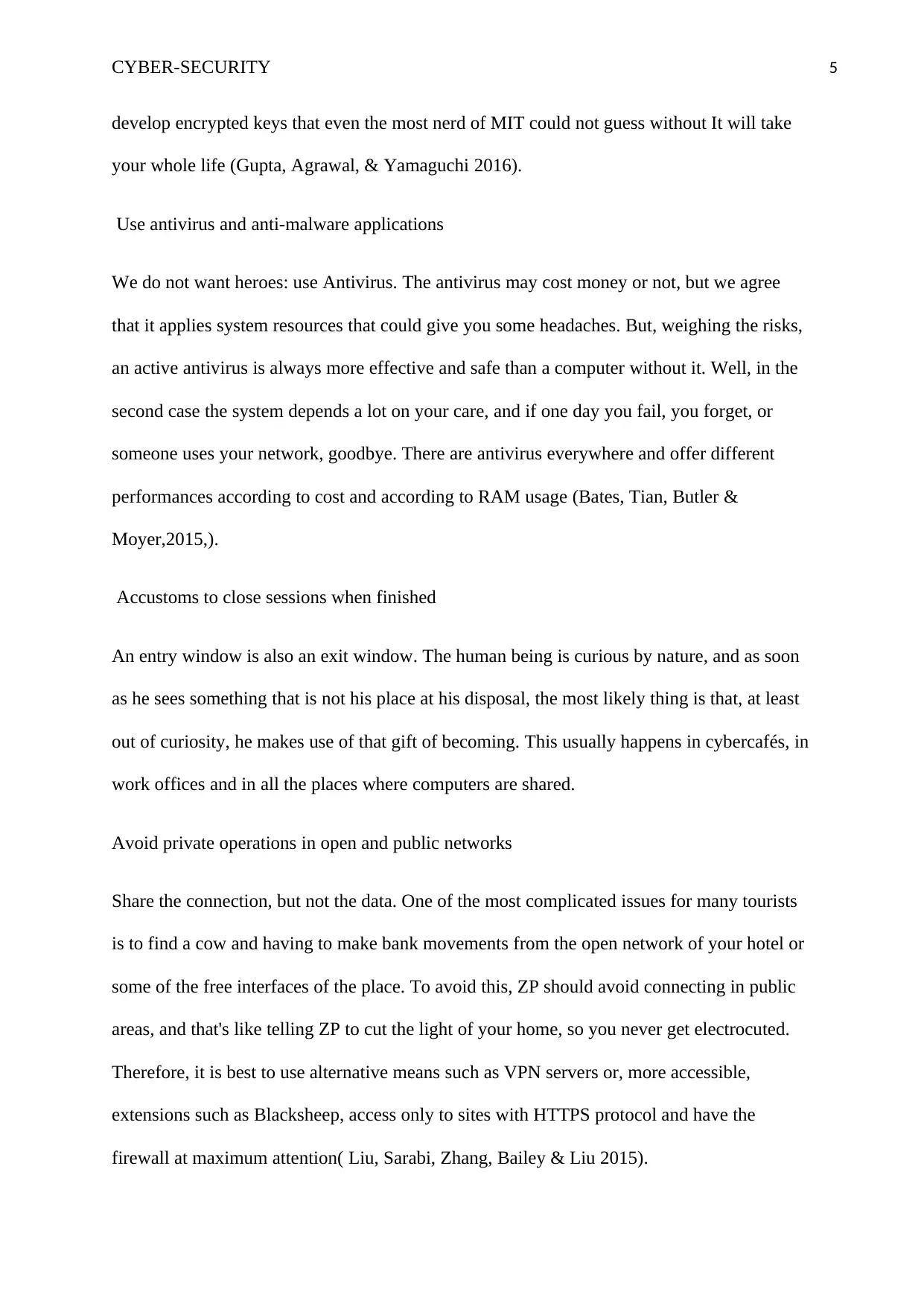
CYBER-SECURITY 5
develop encrypted keys that even the most nerd of MIT could not guess without It will take
your whole life (Gupta, Agrawal, & Yamaguchi 2016).
Use antivirus and anti-malware applications
We do not want heroes: use Antivirus. The antivirus may cost money or not, but we agree
that it applies system resources that could give you some headaches. But, weighing the risks,
an active antivirus is always more effective and safe than a computer without it. Well, in the
second case the system depends a lot on your care, and if one day you fail, you forget, or
someone uses your network, goodbye. There are antivirus everywhere and offer different
performances according to cost and according to RAM usage (Bates, Tian, Butler &
Moyer,2015,).
Accustoms to close sessions when finished
An entry window is also an exit window. The human being is curious by nature, and as soon
as he sees something that is not his place at his disposal, the most likely thing is that, at least
out of curiosity, he makes use of that gift of becoming. This usually happens in cybercafés, in
work offices and in all the places where computers are shared.
Avoid private operations in open and public networks
Share the connection, but not the data. One of the most complicated issues for many tourists
is to find a cow and having to make bank movements from the open network of your hotel or
some of the free interfaces of the place. To avoid this, ZP should avoid connecting in public
areas, and that's like telling ZP to cut the light of your home, so you never get electrocuted.
Therefore, it is best to use alternative means such as VPN servers or, more accessible,
extensions such as Blacksheep, access only to sites with HTTPS protocol and have the
firewall at maximum attention( Liu, Sarabi, Zhang, Bailey & Liu 2015).
develop encrypted keys that even the most nerd of MIT could not guess without It will take
your whole life (Gupta, Agrawal, & Yamaguchi 2016).
Use antivirus and anti-malware applications
We do not want heroes: use Antivirus. The antivirus may cost money or not, but we agree
that it applies system resources that could give you some headaches. But, weighing the risks,
an active antivirus is always more effective and safe than a computer without it. Well, in the
second case the system depends a lot on your care, and if one day you fail, you forget, or
someone uses your network, goodbye. There are antivirus everywhere and offer different
performances according to cost and according to RAM usage (Bates, Tian, Butler &
Moyer,2015,).
Accustoms to close sessions when finished
An entry window is also an exit window. The human being is curious by nature, and as soon
as he sees something that is not his place at his disposal, the most likely thing is that, at least
out of curiosity, he makes use of that gift of becoming. This usually happens in cybercafés, in
work offices and in all the places where computers are shared.
Avoid private operations in open and public networks
Share the connection, but not the data. One of the most complicated issues for many tourists
is to find a cow and having to make bank movements from the open network of your hotel or
some of the free interfaces of the place. To avoid this, ZP should avoid connecting in public
areas, and that's like telling ZP to cut the light of your home, so you never get electrocuted.
Therefore, it is best to use alternative means such as VPN servers or, more accessible,
extensions such as Blacksheep, access only to sites with HTTPS protocol and have the
firewall at maximum attention( Liu, Sarabi, Zhang, Bailey & Liu 2015).
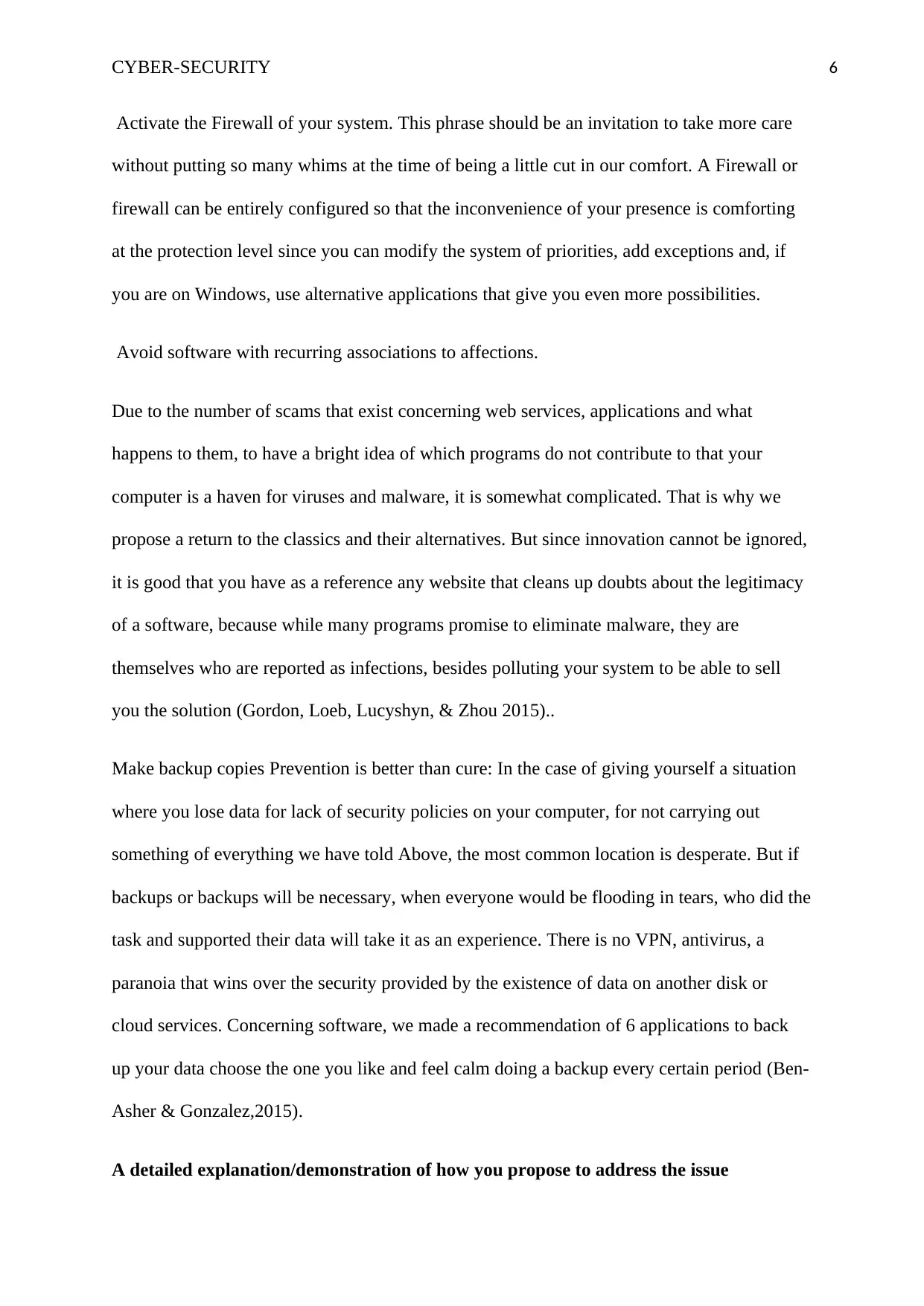
CYBER-SECURITY 6
Activate the Firewall of your system. This phrase should be an invitation to take more care
without putting so many whims at the time of being a little cut in our comfort. A Firewall or
firewall can be entirely configured so that the inconvenience of your presence is comforting
at the protection level since you can modify the system of priorities, add exceptions and, if
you are on Windows, use alternative applications that give you even more possibilities.
Avoid software with recurring associations to affections.
Due to the number of scams that exist concerning web services, applications and what
happens to them, to have a bright idea of which programs do not contribute to that your
computer is a haven for viruses and malware, it is somewhat complicated. That is why we
propose a return to the classics and their alternatives. But since innovation cannot be ignored,
it is good that you have as a reference any website that cleans up doubts about the legitimacy
of a software, because while many programs promise to eliminate malware, they are
themselves who are reported as infections, besides polluting your system to be able to sell
you the solution (Gordon, Loeb, Lucyshyn, & Zhou 2015)..
Make backup copies Prevention is better than cure: In the case of giving yourself a situation
where you lose data for lack of security policies on your computer, for not carrying out
something of everything we have told Above, the most common location is desperate. But if
backups or backups will be necessary, when everyone would be flooding in tears, who did the
task and supported their data will take it as an experience. There is no VPN, antivirus, a
paranoia that wins over the security provided by the existence of data on another disk or
cloud services. Concerning software, we made a recommendation of 6 applications to back
up your data choose the one you like and feel calm doing a backup every certain period (Ben-
Asher & Gonzalez,2015).
A detailed explanation/demonstration of how you propose to address the issue
Activate the Firewall of your system. This phrase should be an invitation to take more care
without putting so many whims at the time of being a little cut in our comfort. A Firewall or
firewall can be entirely configured so that the inconvenience of your presence is comforting
at the protection level since you can modify the system of priorities, add exceptions and, if
you are on Windows, use alternative applications that give you even more possibilities.
Avoid software with recurring associations to affections.
Due to the number of scams that exist concerning web services, applications and what
happens to them, to have a bright idea of which programs do not contribute to that your
computer is a haven for viruses and malware, it is somewhat complicated. That is why we
propose a return to the classics and their alternatives. But since innovation cannot be ignored,
it is good that you have as a reference any website that cleans up doubts about the legitimacy
of a software, because while many programs promise to eliminate malware, they are
themselves who are reported as infections, besides polluting your system to be able to sell
you the solution (Gordon, Loeb, Lucyshyn, & Zhou 2015)..
Make backup copies Prevention is better than cure: In the case of giving yourself a situation
where you lose data for lack of security policies on your computer, for not carrying out
something of everything we have told Above, the most common location is desperate. But if
backups or backups will be necessary, when everyone would be flooding in tears, who did the
task and supported their data will take it as an experience. There is no VPN, antivirus, a
paranoia that wins over the security provided by the existence of data on another disk or
cloud services. Concerning software, we made a recommendation of 6 applications to back
up your data choose the one you like and feel calm doing a backup every certain period (Ben-
Asher & Gonzalez,2015).
A detailed explanation/demonstration of how you propose to address the issue
⊘ This is a preview!⊘
Do you want full access?
Subscribe today to unlock all pages.

Trusted by 1+ million students worldwide

CYBER-SECURITY 7
When dealing with cybersecurity concerning data protection, the following should be done to
ensure ZP is done to its best in securing its data from external extrusion and malware. The
following should be done;
1. Keep the programs updated
There is malware that takes advantage of vulnerabilities infamous programs to sneak into the
PC without the antivirus being able to act. An example: the Police Virus.
2. On public networks, navigate with encryption
In public WiFi networks, the companies data can be intercepted in many ways. Browsing
from them without protection is an imprudence that is very expensive. To defend yourself,
always navigate with the HTTPS protocol activated; with HTTPS Everywhere is very easy.
Additionally, it is important to add extra security, I recommend using these apps.
3. Create different users and passwords
Almost every day there is news about stolen passwords in essential services. The risk of
entering your accounts once a service is attacked is enormous. Create different and secure
passwords for all your services, and use different usernames when given that option.
4. Change your passwords often
Passwords get old. And if they are violated by a discreet intruder, it may take a long time to
know if someone has accessed your files and messages. No matter how strong your
passwords are, change them periodically. And to add protection factor, activate the
verification in two steps wherever you can(Ball,2017).
5. Check the authorized apps
When dealing with cybersecurity concerning data protection, the following should be done to
ensure ZP is done to its best in securing its data from external extrusion and malware. The
following should be done;
1. Keep the programs updated
There is malware that takes advantage of vulnerabilities infamous programs to sneak into the
PC without the antivirus being able to act. An example: the Police Virus.
2. On public networks, navigate with encryption
In public WiFi networks, the companies data can be intercepted in many ways. Browsing
from them without protection is an imprudence that is very expensive. To defend yourself,
always navigate with the HTTPS protocol activated; with HTTPS Everywhere is very easy.
Additionally, it is important to add extra security, I recommend using these apps.
3. Create different users and passwords
Almost every day there is news about stolen passwords in essential services. The risk of
entering your accounts once a service is attacked is enormous. Create different and secure
passwords for all your services, and use different usernames when given that option.
4. Change your passwords often
Passwords get old. And if they are violated by a discreet intruder, it may take a long time to
know if someone has accessed your files and messages. No matter how strong your
passwords are, change them periodically. And to add protection factor, activate the
verification in two steps wherever you can(Ball,2017).
5. Check the authorized apps
Paraphrase This Document
Need a fresh take? Get an instant paraphrase of this document with our AI Paraphraser
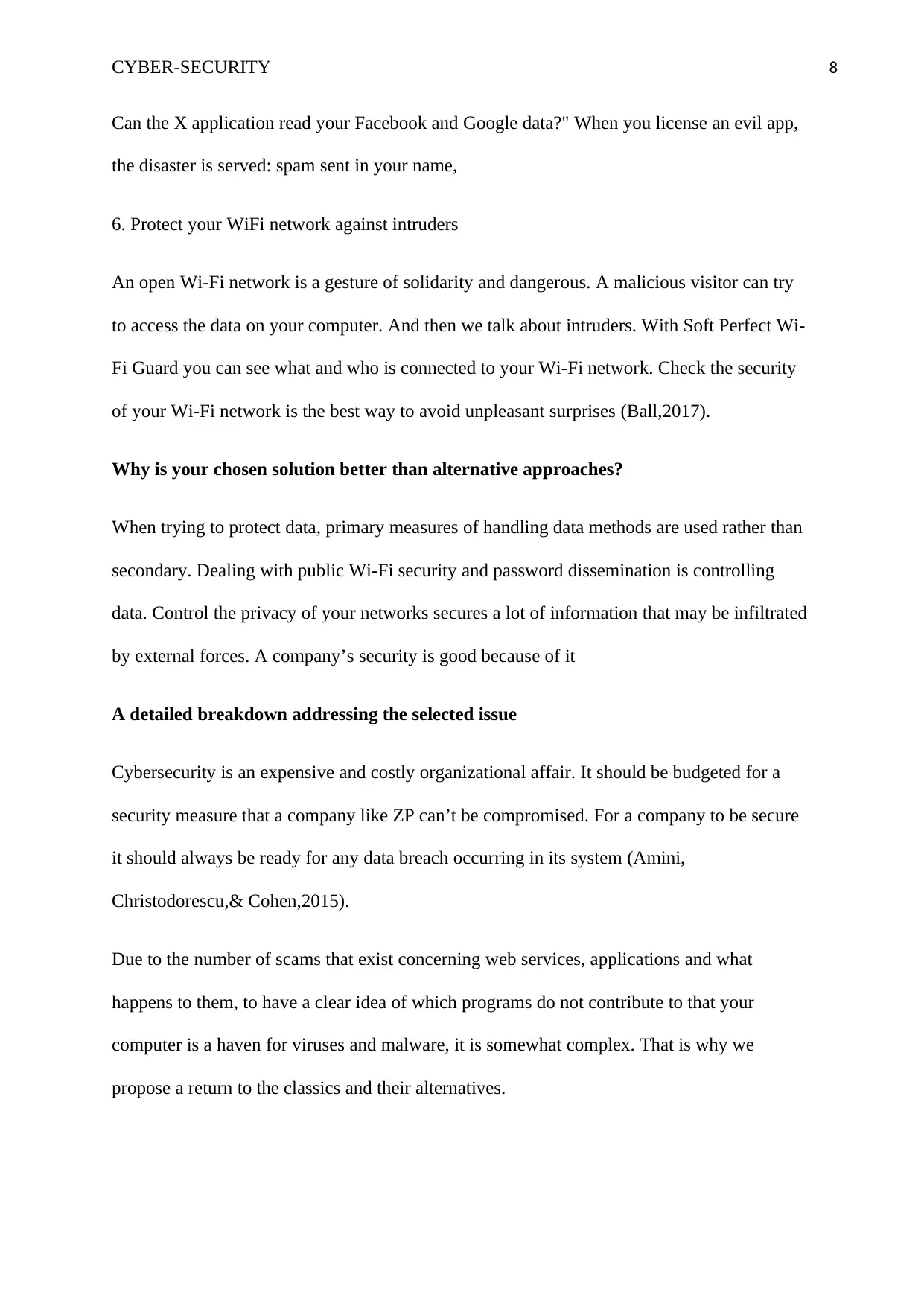
CYBER-SECURITY 8
Can the X application read your Facebook and Google data?" When you license an evil app,
the disaster is served: spam sent in your name,
6. Protect your WiFi network against intruders
An open Wi-Fi network is a gesture of solidarity and dangerous. A malicious visitor can try
to access the data on your computer. And then we talk about intruders. With Soft Perfect Wi-
Fi Guard you can see what and who is connected to your Wi-Fi network. Check the security
of your Wi-Fi network is the best way to avoid unpleasant surprises (Ball,2017).
Why is your chosen solution better than alternative approaches?
When trying to protect data, primary measures of handling data methods are used rather than
secondary. Dealing with public Wi-Fi security and password dissemination is controlling
data. Control the privacy of your networks secures a lot of information that may be infiltrated
by external forces. A company’s security is good because of it
A detailed breakdown addressing the selected issue
Cybersecurity is an expensive and costly organizational affair. It should be budgeted for a
security measure that a company like ZP can’t be compromised. For a company to be secure
it should always be ready for any data breach occurring in its system (Amini,
Christodorescu,& Cohen,2015).
Due to the number of scams that exist concerning web services, applications and what
happens to them, to have a clear idea of which programs do not contribute to that your
computer is a haven for viruses and malware, it is somewhat complex. That is why we
propose a return to the classics and their alternatives.
Can the X application read your Facebook and Google data?" When you license an evil app,
the disaster is served: spam sent in your name,
6. Protect your WiFi network against intruders
An open Wi-Fi network is a gesture of solidarity and dangerous. A malicious visitor can try
to access the data on your computer. And then we talk about intruders. With Soft Perfect Wi-
Fi Guard you can see what and who is connected to your Wi-Fi network. Check the security
of your Wi-Fi network is the best way to avoid unpleasant surprises (Ball,2017).
Why is your chosen solution better than alternative approaches?
When trying to protect data, primary measures of handling data methods are used rather than
secondary. Dealing with public Wi-Fi security and password dissemination is controlling
data. Control the privacy of your networks secures a lot of information that may be infiltrated
by external forces. A company’s security is good because of it
A detailed breakdown addressing the selected issue
Cybersecurity is an expensive and costly organizational affair. It should be budgeted for a
security measure that a company like ZP can’t be compromised. For a company to be secure
it should always be ready for any data breach occurring in its system (Amini,
Christodorescu,& Cohen,2015).
Due to the number of scams that exist concerning web services, applications and what
happens to them, to have a clear idea of which programs do not contribute to that your
computer is a haven for viruses and malware, it is somewhat complex. That is why we
propose a return to the classics and their alternatives.
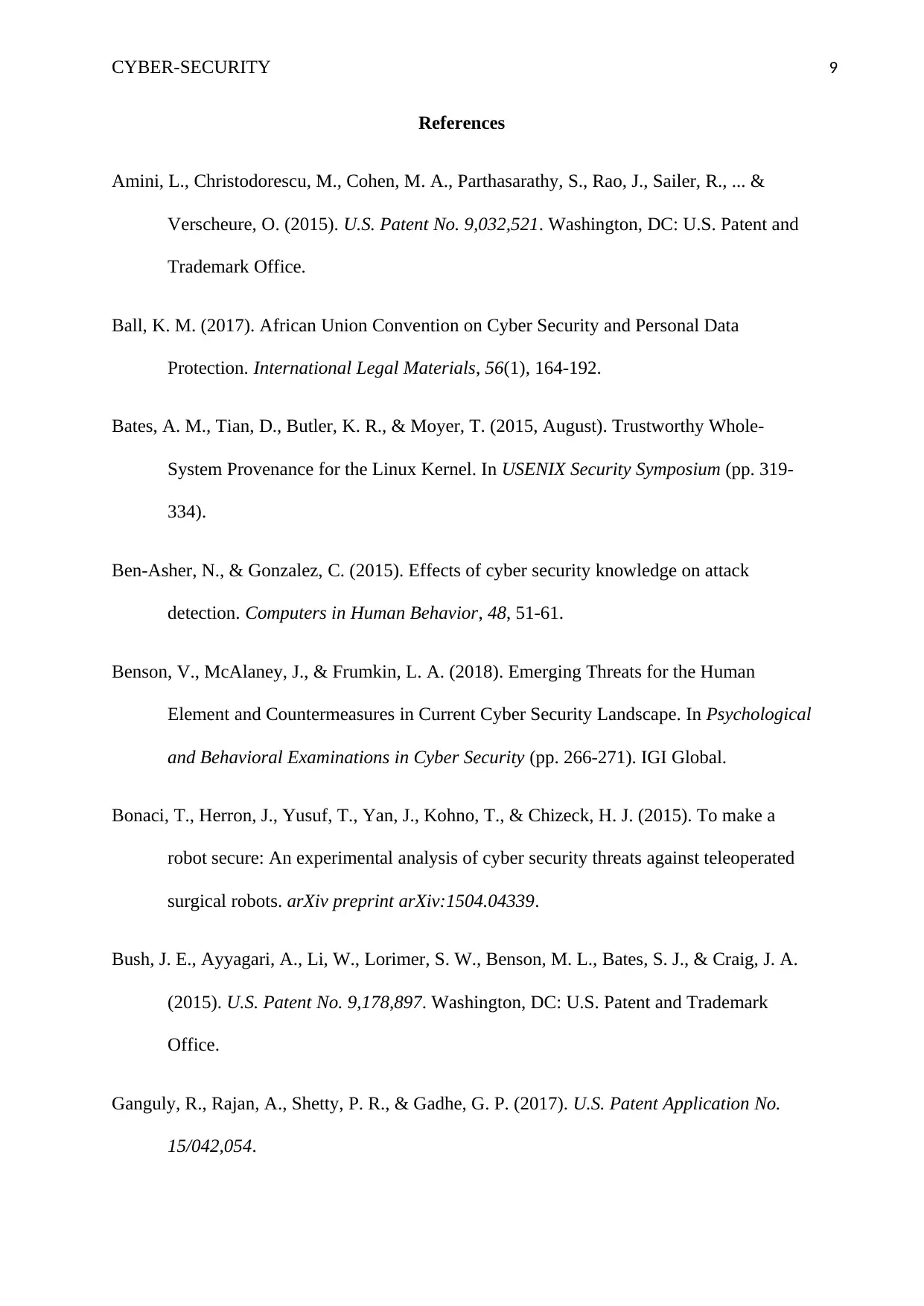
CYBER-SECURITY 9
References
Amini, L., Christodorescu, M., Cohen, M. A., Parthasarathy, S., Rao, J., Sailer, R., ... &
Verscheure, O. (2015). U.S. Patent No. 9,032,521. Washington, DC: U.S. Patent and
Trademark Office.
Ball, K. M. (2017). African Union Convention on Cyber Security and Personal Data
Protection. International Legal Materials, 56(1), 164-192.
Bates, A. M., Tian, D., Butler, K. R., & Moyer, T. (2015, August). Trustworthy Whole-
System Provenance for the Linux Kernel. In USENIX Security Symposium (pp. 319-
334).
Ben-Asher, N., & Gonzalez, C. (2015). Effects of cyber security knowledge on attack
detection. Computers in Human Behavior, 48, 51-61.
Benson, V., McAlaney, J., & Frumkin, L. A. (2018). Emerging Threats for the Human
Element and Countermeasures in Current Cyber Security Landscape. In Psychological
and Behavioral Examinations in Cyber Security (pp. 266-271). IGI Global.
Bonaci, T., Herron, J., Yusuf, T., Yan, J., Kohno, T., & Chizeck, H. J. (2015). To make a
robot secure: An experimental analysis of cyber security threats against teleoperated
surgical robots. arXiv preprint arXiv:1504.04339.
Bush, J. E., Ayyagari, A., Li, W., Lorimer, S. W., Benson, M. L., Bates, S. J., & Craig, J. A.
(2015). U.S. Patent No. 9,178,897. Washington, DC: U.S. Patent and Trademark
Office.
Ganguly, R., Rajan, A., Shetty, P. R., & Gadhe, G. P. (2017). U.S. Patent Application No.
15/042,054.
References
Amini, L., Christodorescu, M., Cohen, M. A., Parthasarathy, S., Rao, J., Sailer, R., ... &
Verscheure, O. (2015). U.S. Patent No. 9,032,521. Washington, DC: U.S. Patent and
Trademark Office.
Ball, K. M. (2017). African Union Convention on Cyber Security and Personal Data
Protection. International Legal Materials, 56(1), 164-192.
Bates, A. M., Tian, D., Butler, K. R., & Moyer, T. (2015, August). Trustworthy Whole-
System Provenance for the Linux Kernel. In USENIX Security Symposium (pp. 319-
334).
Ben-Asher, N., & Gonzalez, C. (2015). Effects of cyber security knowledge on attack
detection. Computers in Human Behavior, 48, 51-61.
Benson, V., McAlaney, J., & Frumkin, L. A. (2018). Emerging Threats for the Human
Element and Countermeasures in Current Cyber Security Landscape. In Psychological
and Behavioral Examinations in Cyber Security (pp. 266-271). IGI Global.
Bonaci, T., Herron, J., Yusuf, T., Yan, J., Kohno, T., & Chizeck, H. J. (2015). To make a
robot secure: An experimental analysis of cyber security threats against teleoperated
surgical robots. arXiv preprint arXiv:1504.04339.
Bush, J. E., Ayyagari, A., Li, W., Lorimer, S. W., Benson, M. L., Bates, S. J., & Craig, J. A.
(2015). U.S. Patent No. 9,178,897. Washington, DC: U.S. Patent and Trademark
Office.
Ganguly, R., Rajan, A., Shetty, P. R., & Gadhe, G. P. (2017). U.S. Patent Application No.
15/042,054.
⊘ This is a preview!⊘
Do you want full access?
Subscribe today to unlock all pages.

Trusted by 1+ million students worldwide
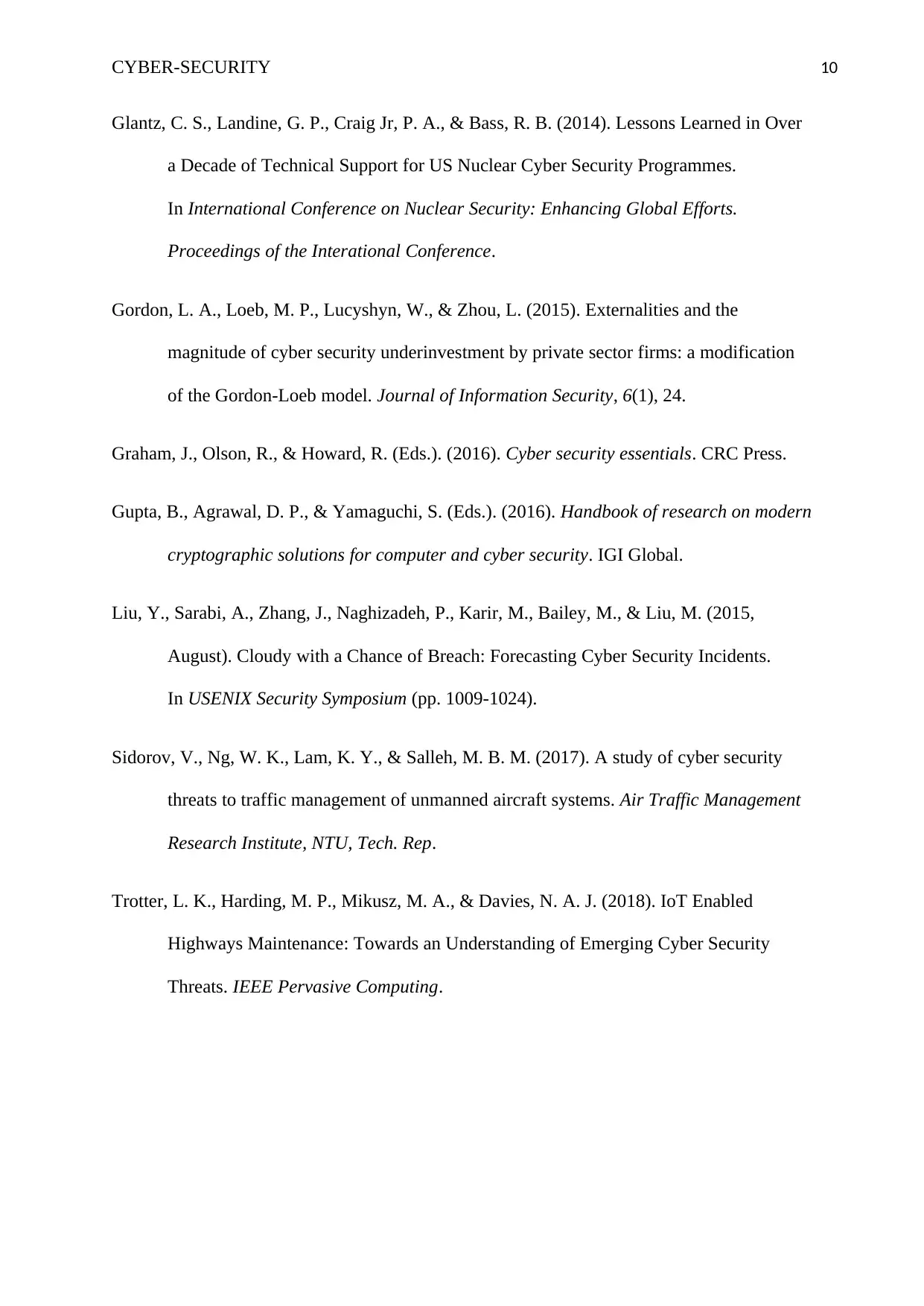
CYBER-SECURITY 10
Glantz, C. S., Landine, G. P., Craig Jr, P. A., & Bass, R. B. (2014). Lessons Learned in Over
a Decade of Technical Support for US Nuclear Cyber Security Programmes.
In International Conference on Nuclear Security: Enhancing Global Efforts.
Proceedings of the Interational Conference.
Gordon, L. A., Loeb, M. P., Lucyshyn, W., & Zhou, L. (2015). Externalities and the
magnitude of cyber security underinvestment by private sector firms: a modification
of the Gordon-Loeb model. Journal of Information Security, 6(1), 24.
Graham, J., Olson, R., & Howard, R. (Eds.). (2016). Cyber security essentials. CRC Press.
Gupta, B., Agrawal, D. P., & Yamaguchi, S. (Eds.). (2016). Handbook of research on modern
cryptographic solutions for computer and cyber security. IGI Global.
Liu, Y., Sarabi, A., Zhang, J., Naghizadeh, P., Karir, M., Bailey, M., & Liu, M. (2015,
August). Cloudy with a Chance of Breach: Forecasting Cyber Security Incidents.
In USENIX Security Symposium (pp. 1009-1024).
Sidorov, V., Ng, W. K., Lam, K. Y., & Salleh, M. B. M. (2017). A study of cyber security
threats to traffic management of unmanned aircraft systems. Air Traffic Management
Research Institute, NTU, Tech. Rep.
Trotter, L. K., Harding, M. P., Mikusz, M. A., & Davies, N. A. J. (2018). IoT Enabled
Highways Maintenance: Towards an Understanding of Emerging Cyber Security
Threats. IEEE Pervasive Computing.
Glantz, C. S., Landine, G. P., Craig Jr, P. A., & Bass, R. B. (2014). Lessons Learned in Over
a Decade of Technical Support for US Nuclear Cyber Security Programmes.
In International Conference on Nuclear Security: Enhancing Global Efforts.
Proceedings of the Interational Conference.
Gordon, L. A., Loeb, M. P., Lucyshyn, W., & Zhou, L. (2015). Externalities and the
magnitude of cyber security underinvestment by private sector firms: a modification
of the Gordon-Loeb model. Journal of Information Security, 6(1), 24.
Graham, J., Olson, R., & Howard, R. (Eds.). (2016). Cyber security essentials. CRC Press.
Gupta, B., Agrawal, D. P., & Yamaguchi, S. (Eds.). (2016). Handbook of research on modern
cryptographic solutions for computer and cyber security. IGI Global.
Liu, Y., Sarabi, A., Zhang, J., Naghizadeh, P., Karir, M., Bailey, M., & Liu, M. (2015,
August). Cloudy with a Chance of Breach: Forecasting Cyber Security Incidents.
In USENIX Security Symposium (pp. 1009-1024).
Sidorov, V., Ng, W. K., Lam, K. Y., & Salleh, M. B. M. (2017). A study of cyber security
threats to traffic management of unmanned aircraft systems. Air Traffic Management
Research Institute, NTU, Tech. Rep.
Trotter, L. K., Harding, M. P., Mikusz, M. A., & Davies, N. A. J. (2018). IoT Enabled
Highways Maintenance: Towards an Understanding of Emerging Cyber Security
Threats. IEEE Pervasive Computing.
1 out of 10
Related Documents
Your All-in-One AI-Powered Toolkit for Academic Success.
+13062052269
info@desklib.com
Available 24*7 on WhatsApp / Email
![[object Object]](/_next/static/media/star-bottom.7253800d.svg)
Unlock your academic potential
Copyright © 2020–2025 A2Z Services. All Rights Reserved. Developed and managed by ZUCOL.





